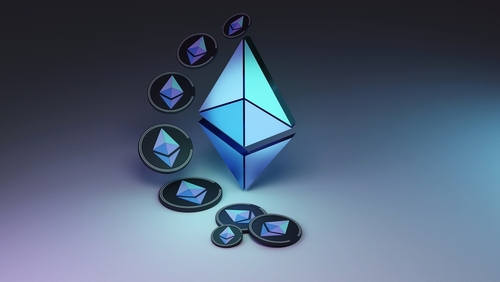

The big news this week has been the completion of the ethereum merge (the transition from proof-of-work to proof-of-stake). Ethereum initially bounced around 2% after the merge, but it has since plunged to around $1,450 (down 10% since yesterday). In comparison, bitcoin is down only 3% over the past 24 hours. Consequently, the ETH/BTC cross has been trending down.
Buy The Rumour, Sell The News?
One narrative around ethereum’s underperformance in the immediate aftermath of the merge is the classic ‘buy the rumour, sell the news’ event. Record net inflows to exchanges of around 980,000 ETH on 14 September (a day before the merge) supports this – large inflows to exchanges are associated with increased sell pressure.
This article is only available to Macro Hive subscribers. Sign-up to receive world-class macro analysis with a daily curated newsletter, podcast, original content from award-winning researchers, cross market strategy, equity insights, trade ideas, crypto flow frameworks, academic paper summaries, explanation and analysis of market-moving events, community investor chat room, and more.
The big news this week has been the completion of the ethereum merge (the transition from proof-of-work to proof-of-stake). Ethereum initially bounced around 2% after the merge, but it has since plunged to around $1,450 (down 10% since yesterday). In comparison, bitcoin is down only 3% over the past 24 hours. Consequently, the ETH/BTC cross has been trending down.
Buy The Rumour, Sell The News?
One narrative around ethereum’s underperformance in the immediate aftermath of the merge is the classic ‘buy the rumour, sell the news’ event. Record net inflows to exchanges of around 980,000 ETH on 14 September (a day before the merge) supports this – large inflows to exchanges are associated with increased sell pressure.
There are other potential explanations. A lot of the inflows were to exchanges supporting derivatives. With the prospect of a proof-of-work fork (ETHW), a popular trade was to be long one ETH and short one ETH futures to receive an airdropped ETHW for ‘free.’ Indeed, the perpetual funding rate reached lows of around -0.45% in the hours before the merge and sharply normalised back up towards 0% in the hours after. This indicates some unwinding of that trade and merge related hedges in general. If you are wondering, ‘should I buy ethereum?’, we outline the short-term drivers below.
More Upgrades To Come
It is also important to note that the merge is just one part of a long series of upgrades planned for ethereum. The next upgrade, called the Shanghai upgrade, is expected to take place in early 2023 and is expected to introduce Beacon Chain withdrawals which would allow validators to withdraw their staked ETH.
Negative Macroeconomic Outlook Remains
On the macro front, crypto markets fell off a cliff after hotter-than-expected August CPI (+8.3%) data came in on Tuesday. The dominant driver behind crypto market sentiment is still macroeconomic pressures and central bank policies. Indeed, all eyes are on the 20-21 September FOMC meeting – we expect 75bps (markets are pricing a 20% chance of 100bps) and 175bps by end-2022. Accelerating inflation and rate hikes maintain the negative macroeconomic outlook for crypto markets.
Performance of Our Indices
As for our various indices, performance is largely negative. Our Smart Contract (-17% WoW) and DeFi (-17% WoW) indices fared worst. Underperformance in both is partly due to Terra Luna Classic (LUNC, the original token of the Terra blockchain) plummeting 50% over the past seven days. Our Metaverse (-4% Wow) and Privacy (-1% WoW) indices were also down. Bitcoin (+2% WoW) was the only index to register a gain.
Our Metaverse (89%) and Privacy (83%) indices are correlated most to bitcoin while our DeFi (54%) and Smart Contract (57%) indices are correlated least to bitcoin (Chart 3). On macro markets, bitcoin’s correlation to tech fell below 50% and its correlation to Gold (50%) jumped (Chart 4).
- Smart Contract Platform Index: all coins are down WoW except for Chainlink (LINK) which is up 2%. Terra Luna Classic (LUNC) is down the most at 50% Ethereum (ETH) is down 11%.
- DeFi Index: all coins are down except for Compound (COMP) which is up 17%. Terra Luna Classic (LUNC) is down the most at 50%.
- Metaverse Index: all coins are down except for RedFOX Labs (RFOX) and Ultra (UOS) which are up 8% and 7% WoW, respectively. The Virtua Kolect (TVK) is down the most at 10%.
- Privacy Index: Beam (BEAM) is up the most WoW at 25% and Decred (DCR) is down the most at 9%.
- Bitcoin: this is up 2% WoW.


What Are in the Four Indices?
Here are the indices in more detail:
- Bitcoin: the OG of crypto markets deserves its own category and is in many ways the true benchmark for any other crypto market.
- Smart contract platforms: after bitcoin, the big innovation was to have blockchains that were more programmable. These could host smart contracts or decentralised applications and have allowed the emergence of the metaverse and defi. Ethereum (ETH) is the most popular version of a smart contract platform. As well as ethereum, we also include some key competitors. The constituents of this index are: Ethereum (ETH), Cardano (ADA), Avalanche (AVAX), Solana (SOL), Fantom (FTM), VeChain (VET), Terra (LUNA), EOS (EOS), and Chainlink (LINK). We also include Polkadot (DOT) which allows interoperability between blockchains and the use of smart contracts via parachains.
- Metaverse: coins associated with the creation of a virtual space/digital world on the internet using a combination of augmented reality, virtual reality, and social networks. The constituents of this index are Axie Infinity (AXS), The Sandbox (SAND), Decentraland (MANA), Enjin Coin (ENJ), Aavegotchi (GHST), Terra Virtua Kolect (TVK), Ultra (UOS), Phantasma (SOUL), RedFOX Labs (RFOX), and Gala (GALA).
- Decentralised Finance (DeFi): financial services built on top of blockchain networks with no central intermediaries. This can be a broad category, so we narrow this down to platforms that focus on lending/borrowing, yield farming, automated market making and decentralised exchange tokens. The constituents of this index are: Aave (AAVE), Compound (COMP), Uniswap (UNI), Yearn.finance (YFI), Loopring (LRC), PancakeSwap (CAKE), Maker (MKR), 1inch (1INCH), Thorchain (RUNE), and Terra (LUNA).
- Privacy Coins: coins that obscure transactions on the blockchain to maintain the anonymity of its users and their activity. The constituents of this index are Monero (XMR), Zcash (ZEC), Dash (DASH), Verge (XVG), Horizen (ZEN), Beam (BEAM), Secret (SCRT), Decred (DCR), Keep Network (KEEP), and Dusk Network (DUSK).
Dalvir Mandara is a Quantitative Researcher at Macro Hive. Dalvir has a BSc Mathematics and Computer Science and an MSc Mathematical Finance both from the University of Birmingham. His areas of interest are in the applications of machine learning, deep learning and alternative data for predictive modelling of financial markets.
Bilal Hafeez is the CEO and Editor of Macro Hive. He spent over twenty years doing research at big banks – JPMorgan, Deutsche Bank, and Nomura, where he had various “Global Head” roles and did FX, rates and cross-markets research.
